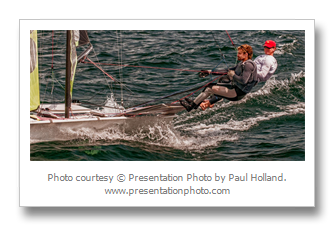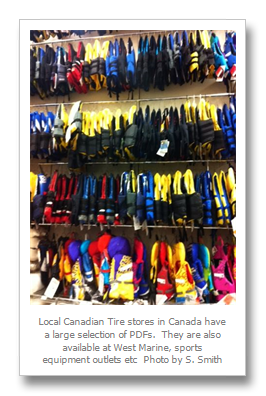We all remember that great summer day when we passed our first real test on the river: “If you can swim from our dock to Granny’s dock, and back, you won’t have to wear that lifejacket anymore”. It was a summer rite of passage for all of us enjoying the rivers and lakes of Canada. When the ‘water wings’ came off they stayed off. That memorable event set a general frame of mind; we were big boys and girls now and that lifejacket would no longer be required. We should have been told that we did not need to wear a lifejacket while swimming, but that there will be occasions when the jacket “will be on”, period. (Kudos to those adults that did lay that rule down.)

Today most people getting on a personal water craft, sea-doo, paddle board, or in a canoe or kayak, will usually put on a personal flotation device (PFD). It’s as normal as clicking on your seat belt before driving. That practice grew as we took to different smaller water craft but not so in boats. Why not? Because of that age-old rite of passage? In recent years changes in the law requires PFD’s to be ‘on board’ each & every category of pleasure craft: the law does not stipulate it be worn. That might explain why the greatest number of ‘water’ fatalities still occur when boating.
There is an exception to the law, in that inflatable lifejackets must be worn at all times, if being relied upon as a life jacket.
A recent issue of a Canadian leisure magazine has a full-page ad for a popular brand of outboard motor. The ad depicts a young smiling boy, holding a fishing rod, and a grandfatherly figure in a boat. Sonny boy is wearing a PFD; grandpa is not. Nice image, wrong message.
Years ago I was involved, as a scuba diver, with a volunteer search and rescue group. When called upon to assist it was not to ‘rescue’ but rather to ‘recover’ a drowning victim. The recurring impressions of those tragedies are of the grieving families and that none of the recovered victims had worn a lifejacket. Sadly that is as true today as it was forty years ago. It is a given that accidents will happen, be it on the road or on the water. However, water accidents have a heightened element of unpredictability and angst while awaiting the recovery of the lost loved one. Family fabric is torn apart and changed forever. Having lost a family member to drowning, I can attest to this.

Most of those recovery episodes were related to accidents; collisions, falling out of a boat, impact with terra firma, capsizing or weather related. Again this fact is as true today as it was years ago but today we have more to be concerned about than yesteryear because of how boating has changed: recreational boating is increasingly more popular, more boats, bigger, faster crafts. (Oh, did I mention noisier also?)
Today all operators of pleasure water crafts are required to have a ‘boater’s card’. This card, issued by Transport Canada, attests that the craft operator has successfully passed a multiple choice question test, related to safety procedures, equipment and the ‘the rules of the road’. Other than the under-12 and under-16 age restrictions noted in the Transport Canada publication, “Safe Boating Guide”, nothing affirms the individual’s competency to operate a pleasure craft specific to the size, weight or horse power.

Motor vehicle and aircraft licenses require, and are issued, on the basis of a demonstrated competence in the handling, safety, and operation by class and category of vehicle or aircraft. The mandated boater’s card system does not differentiate between the boater putt-putting along with his 10 hp ‘tinny’ or the proud owner of an 800 plus hp behemoth zooming along with the emblazoned ‘check me-out’ paint scheme. There is no gradation of competency verification requirements, specific to the operation of pleasure crafts. Things can go wrong on the water much faster now and boaters, sans PFD, will seldom have time to get one on, when bad things do happen; too late to sort-out location, size and fit.
Today an on-the-water conversation with any authority will most likely include a request for the operator’s boater card and will, no doubt, ask if there are sufficient PFD’s on-board. If there are not sufficient approved lifejackets, the operator could be $200 poorer, plus $100 poorer for each person without an available PFD.
A review of fatality statistics, at this point, might be considered more like tut-tutting and finger pointing, but it’s significant: Between 2010 and 2014 there were 115 water fatalities in Ontario. According to the Ontario Provincial Police investigators, 96 of those could have survived had they been wearing a PFD.
The good news from our OPP Marine Division: “Recent boating incident investigations have revealed a ten-year low in boating fatalities”. The bad news: “Not wearing a PFD continues to be the contributing factor in the overwhelming majority of the deaths each year”.
The most important statistic is ‘1’; one more fatality is one too many when most are avoidable.
By the way, have you seen the latest fashions in PFD’s? The newer ones sure beat the old bulky ‘DD’ size. These are more compact, unobtrusive and comfortable to wear.
Next time you get in a boat, think about your family, your loved ones and just put the PFD on. It’s a habit you can get into. It’s a decision you can live with.
By Terry Bambrick
Terry Bambrick originally hales from Ottawa and worked in engineering management in the pulp and paper industry in Canada, USA and abroad. He is well known and popular in the Gananoque region for encouraging boating safety. Many a youngster (and adult) has been made a member of the 'River Mouse Club' when Terry finds them WEARING their life jackets.